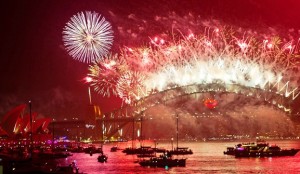 Sydney Harbour is, without doubt, one of the most beautiful harbours in the world. Australian writer, Ruth Park, called it ‘beautiful as a dream, laid upon the map like a branch of blue coral.’ Taking full advantage of this enviable reputation and location, Sydney has been turning on sensational New Year’s Eve fireworks displays since 1996.
Sydney Harbour is, without doubt, one of the most beautiful harbours in the world. Australian writer, Ruth Park, called it ‘beautiful as a dream, laid upon the map like a branch of blue coral.’ Taking full advantage of this enviable reputation and location, Sydney has been turning on sensational New Year’s Eve fireworks displays since 1996.
The inspiration for this pyrotechnic spectacular came from New York, where the Brooklyn Bridge became the focus of a fireworks display in 1983 to celebrate its 100th birthday. Syd Howard, a pyro technician, borrowed the idea in 1986 for the 75th Anniversary of the Royal Australian Navy, and organized a display off Sydney Harbour Bridge. In 2012, the New Year’s Eve fireworks display involved seven barges, seven city buildings and over six and a half million dollars worth of fireworks, set off at both 9pm and midnight.
There is a wealth of vantage points both on and around the harbour: champagne in hand, perched in high-rise eeries overlooking the harbour, or camped on a picnic rug in one of the many public parks along the shoreline. In past years, we have been lucky enough to have watched the fireworks from a balcony high above Blues Point Road, where we felt we could almost touch the bridge, and from a Pyrmont apartment block, looking down into Darling Harbour.
This year we found ourselves with friends on a rooftop in Cremorne with a view across almost  the entire expanse of the harbour. Impossible to describe in words the spectacle of colour and light: the bursts of dandelion clocks in all the colours of the rainbow; the fountains of gold and silver erupting off the Harbour Bridge; the giant Roman candles spurting up into the sky. The adults gasped and gushed like a bunch of small kids, while our teenage sons mocked and mimicked. Helicopters from various TV stations hovered overhead, while Jamie Packer’s new luxury yacht ‘Seahorse’ glowed on the skyline in Rose Bay like a huge marquee. And everywhere across Sydney we glimpsed sudden flares of colour and flame, punctuating the immense, fantastical eruptions around the harbour.
the entire expanse of the harbour. Impossible to describe in words the spectacle of colour and light: the bursts of dandelion clocks in all the colours of the rainbow; the fountains of gold and silver erupting off the Harbour Bridge; the giant Roman candles spurting up into the sky. The adults gasped and gushed like a bunch of small kids, while our teenage sons mocked and mimicked. Helicopters from various TV stations hovered overhead, while Jamie Packer’s new luxury yacht ‘Seahorse’ glowed on the skyline in Rose Bay like a huge marquee. And everywhere across Sydney we glimpsed sudden flares of colour and flame, punctuating the immense, fantastical eruptions around the harbour.
It was such a joy to be back in Sydney, although there was only time for a taster, a speedy degustation menu. New Year revelleries and revisiting old haunts, we sauntered through suburban streets and national parks, along the beaches and around the City.
 Bobbin Head National Park is a hidden treasure at the bottom of a steeply spiralling road from North Turramurra that opens out into a wide expanse of park and playground cluttered with young families picnicking. A marina nearby is choc-a-block with boats, and has a good café on the edge of the water. We used to love following the fire trails through the heavy bushland or meandering along the mangrove board walk, where the trees creep right down to the water’s edge, watching fishermen perching on the rocks, or crabs flashing across the mud and out of sight down tiny, round tunnels.
Bobbin Head National Park is a hidden treasure at the bottom of a steeply spiralling road from North Turramurra that opens out into a wide expanse of park and playground cluttered with young families picnicking. A marina nearby is choc-a-block with boats, and has a good café on the edge of the water. We used to love following the fire trails through the heavy bushland or meandering along the mangrove board walk, where the trees creep right down to the water’s edge, watching fishermen perching on the rocks, or crabs flashing across the mud and out of sight down tiny, round tunnels.
Cremorne Point, on the north shore, is a visual delight with its beautiful old federation homes, apartment buildings and former boarding houses clinging to the steep rocky sides, lawns melting into gay rockeries or a wilderness of clinging, creeping vines. On the eastern side of the peninsula are the Lex and Ruby Graham Gardens, created by local residents Lex and Ruby Graham, (surprise, surprise) who began years of work on these attractive gardens in 1959.
Eventually reaching the Cremorne Point ferry wharf, we rode across the harbour on a catamaran, a flirty wind twirling and twisting my hair, the catamaran dipping in and out of the small bays along the lower north shore, before making a mad dash across the middle of the harbour, miraculously dodging yachts, motor boats, ferries and kayaks with practiced ease. We bustle into Circular Quay, seething with tourists, the haunting sound of a didgeridoo blasting through a tinny sound system.
 On the right hand side of the Quay, a mammoth cruise ship dwarfed every building in the vicinity. Cowering in its shadow, we discovered the Museum of Contemporary Art, which has recently had a facelift and was housing an exhibition exploring the issues of taboo across different cultures, tracing their origins, their evolution and their impact on society. It was a fascinating exhibition, particularly a series of pieces that turned the white man’s perspective of Australia’s history on its head.
On the right hand side of the Quay, a mammoth cruise ship dwarfed every building in the vicinity. Cowering in its shadow, we discovered the Museum of Contemporary Art, which has recently had a facelift and was housing an exhibition exploring the issues of taboo across different cultures, tracing their origins, their evolution and their impact on society. It was a fascinating exhibition, particularly a series of pieces that turned the white man’s perspective of Australia’s history on its head.
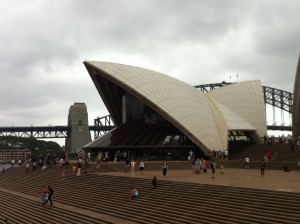 Across Sydney Cove, the iconic sails of the opera house perch on the edge of what used to be the tram terminal, until it was flattened to clear the way for the imaginative creation of Danish architect Jørn Utzon. Almost twenty years from conception to completion, the Opera house opened in 1973 to world-wide acclaim, and was made a UNESCO world heritage site in 2007. Ruth Park, poetic as always, describes it as a ‘handful of white butterflies, at rest on the sparkling water.’ However, walking down Macquarie Street, we noticed that from behind, those butterflies looked more like giant fortune cookies.
Across Sydney Cove, the iconic sails of the opera house perch on the edge of what used to be the tram terminal, until it was flattened to clear the way for the imaginative creation of Danish architect Jørn Utzon. Almost twenty years from conception to completion, the Opera house opened in 1973 to world-wide acclaim, and was made a UNESCO world heritage site in 2007. Ruth Park, poetic as always, describes it as a ‘handful of white butterflies, at rest on the sparkling water.’ However, walking down Macquarie Street, we noticed that from behind, those butterflies looked more like giant fortune cookies.
The equally iconic curve of the Sydney Harbour Bridge has made my skin tingle since the day I first drove across its broad, solid span that links the lush northern suburbs to the tall, stately CBD. This engineering feat would eventually save travelers a nerve-racking trip of 113 miles from Manly to Sydney Cove on a bullock-track rife with bushrangers. A long-held dream from the early days of settlement, Bradfield’s Bridge was finally completed in 1932, having provided work for thousands during the dreadful years of the Depression. 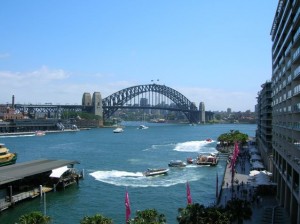 We walked across the bridge from Milson’s Point when it celebrated its 75th birthday on 18 March 2007, in the company of approximately 250,000 other walkers. We were all given orange caps, with a small light attached – it was quite a vision as we looked back over the curve of the bridge, speckled with hundreds of tiny, twinkling, floating lights.
We walked across the bridge from Milson’s Point when it celebrated its 75th birthday on 18 March 2007, in the company of approximately 250,000 other walkers. We were all given orange caps, with a small light attached – it was quite a vision as we looked back over the curve of the bridge, speckled with hundreds of tiny, twinkling, floating lights.
Crossing the Opera House Plaza, we rambled through the green and welcoming space of the Botanic Gardens, with its arms wrapped snuggly around Farm Cove. The broad, green lawns are polka-dotted with bright beds of tall gladioli and shaded by broad-leaved, twisty-rooted Morton Bay Figs. Originally, this land was part of Government House’s gardens and farm, designed in part by the Governor’s wife, Elizabeth Macquarie. Today, we share the wide pathways with joggers and push chairs and scooters and couples munching sandwiches or entwining elbows, before we escape the crowds by ducking down the shady, sinuous tracks that coil and corkscrew through the peaceful gardens.
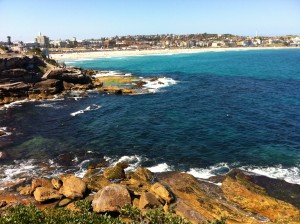 Later in the week, we head down to Bondi Beach, another national icon. It was a hot, summer afternoon, and the sea was churning with bathers and surfers. The beach was thickly spread with bodies, the park along its rim equally coated in baking, singeing sunbathers. We meandered along the serpentine coastal path, skimming around Tamarama (I love that name!) bereft of its annual display of sculptures, but nonetheless attracting walkers and joggers, surfers, sunbathers and swimmers, to end up at a small café overlooking Bronte Beach, relaxing over a mango smoothie.
Later in the week, we head down to Bondi Beach, another national icon. It was a hot, summer afternoon, and the sea was churning with bathers and surfers. The beach was thickly spread with bodies, the park along its rim equally coated in baking, singeing sunbathers. We meandered along the serpentine coastal path, skimming around Tamarama (I love that name!) bereft of its annual display of sculptures, but nonetheless attracting walkers and joggers, surfers, sunbathers and swimmers, to end up at a small café overlooking Bronte Beach, relaxing over a mango smoothie.
Our final day in Sydney was spent at the cricket. A generous gift from an old friend allowed us to 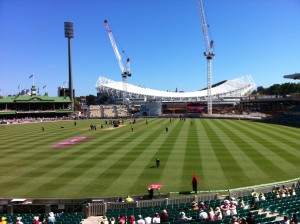 gather with a handful of friends in a private suite at the Sydney Cricket Ground, to watch the second day of the Test Match between Australia and Sri Lanka. I haven’t been to the cricket in years, so it felt amazing to watch the cricketers walk onto the pitch, and the cameraman on his Segway swoop around the players for close-up footage, to see the Coca Cola beach tucked amongst the stands, and a large group of fans impersonating Australian cricket commentator Richie Benaud, decked out in wigs and dark glasses, and armed with Channel 9 microphones! And of course it was great to watch the Australian batsmen attempt to outbat and outrun the Sri Lankans, in Michael Hussey’s final appearance with the Australian Cricket team – between sips of Jaentz champagne and mouthfuls of fresh salmon, oysters and prawns. It was a fitting end to a truly ‘iconic’ holiday!
gather with a handful of friends in a private suite at the Sydney Cricket Ground, to watch the second day of the Test Match between Australia and Sri Lanka. I haven’t been to the cricket in years, so it felt amazing to watch the cricketers walk onto the pitch, and the cameraman on his Segway swoop around the players for close-up footage, to see the Coca Cola beach tucked amongst the stands, and a large group of fans impersonating Australian cricket commentator Richie Benaud, decked out in wigs and dark glasses, and armed with Channel 9 microphones! And of course it was great to watch the Australian batsmen attempt to outbat and outrun the Sri Lankans, in Michael Hussey’s final appearance with the Australian Cricket team – between sips of Jaentz champagne and mouthfuls of fresh salmon, oysters and prawns. It was a fitting end to a truly ‘iconic’ holiday!
*With thanks to Google images for the photos of the fireworks on the bridge and the Bobbin Head boardwalk – and to my talented husband for the rest!
